Newsmaker of the Year: Front-line health care workers | News
In 2020, as COVID-19 stormed the shores of the United States, images from the front line arrived: Nurses and doctors speaking into their cellphone cameras at shift’s end, some near tears, others in tears, all begging us to care — or even just acknowledge — the suffering they’d just witnessed.
They left their homes before dawn, or after sunset, to begin 12-hour shifts spent sweating beneath layers of plastic, breathing through masks and face shields, carrying the weight of life and death into every negative-pressure room assigned to them.
In there, they saw what we didn’t.
They discovered the unique loneliness of sitting in a hospital room with someone dying of COVID-19. A patient’s family might be piped in over FaceTime or Zoom, but the gloved hand still held the dying one.
In South Carolina, medical professionals have cared for more than 4,700 people killed by the virus, so far. That’s roughly the population of towns like the Isle of Palms, Belton or Blythewood — gone in less than a year.
For these reasons, and others, The Post and Courier has chosen front-line health care workers as our 2020 Newsmaker of the Year.
Given their jobs require intimate proximity to infected patients, they have gone to work, day after day, fearful of contracting the virus themselves. And for good reason.
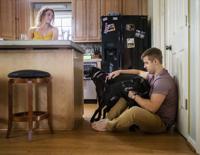
Healthcare workers make up the largest group among South Carolinians who have tested positive for the virus so far and whose occupations state health officials have recorded. Of those nearly 60,000 people, 13,907 of them worked in hospitals, nursing homes, doctor’s offices, laboratories and similar sites, according to data obtained by The Post and Courier.
That’s nearly one in four — and more than twice as many as the next hardest-hit occupations.
Not all of these workers survived. Among the fallen:
A Piedmont EMT just starting his career. A Charleston EMT, 17 years into his.
A Hanahan nursing home caregiver who left a wife and toddler behind.
And a Greenville nurse who died in the very ICU where she worked. Her name was Patricia Edwards, gone at 62.

ICU nurse Jaclyn Purcell (second from left) poses with colleagues working with COVID-19 patients at St. Francis Downtown in Greenville. Provided
Middle man of love
Edwards, a mother of five, died in August at St. Francis Downtown in Greenville. Jaclyn Purcell, one of her coworkers, was among those who never imagined before COVID-19 that she would come to know death quite so intimately.
Normally, when patients neared those final moments, Purcell tried to slip out when family arrived, to give them privacy.
But with visitation halted, Purcell couldn’t leave patients to die alone.
Sitting beside them, she listened to their loves ones’ parting words, delivered over an internet connection. She heard their pet names. Their prayers. Their memories. The songs sang to a parent or sister or husband.
Other times, she relayed messages to the dying, a middle man.
Her own grandmother died in May during the shutdown, though not from COVID. Purcell stood outside a nursing home, watching through a window as the older woman took her final breaths. It was raining that day.
Afterward, a caregiver inside kept the blinds open, the window cracked, and left Purcell’s family alone to say goodbye.
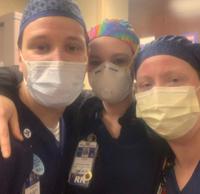
Nurse Jaclyn Purcell (middle) has worked with COVID-19 patients since the pandemic began. A fellow nurse on her unit at St. Francis Downtown in Greenville died of the disease in August. Provided
Purcell had always wondered if it helped families to have that time even after death.
She’d wondered what it was like for her families to say goodbye from afar.
It all felt so very personal.
In the beginning, when the first seriously ill COVID patients arrived on their unit, Purcell would drive to work gripped by panic attacks. She saw nurses leave. Staff got sick. Patricia Edwards died.
For nine months now, she has witnessed suffering the public doesn’t see. She is 27, just two years into her nursing career. This pandemic will define the nurse she is for the rest of it.
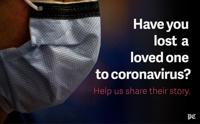
Feeling forgotten
At first, people cheered on these soldiers in scrubs, honking horns and shouting from New York City balconies, organizing drive-by parades at suburban and rural hospitals, and sending them enough donated food to feed several armies.
The workers heard that applause, and appreciated it, then saw politicians and partygoers crowd into rallies and bars. They watched mask-wearing become political fodder.
They read tweets like the one Georgia Congresswoman-elect Marjorie Taylor Greene posted Nov. 13 about Capitol orientation, which included updates about pandemic precautions.
“I proudly told my freshman class that masks are oppressive,” she tweeted, adding #FreeYourFace. The tweet got 18,000 likes.
And so, front-line health care workers used their personal time to speak at local city council meetings, pleading with officials to enact mask requirements.
When Mount Pleasant’s council debated its ordinance, a hospital physician shared a story. He described a healthy middle-age couple who’d gone to a Fourth of July party where no one wore a mask.
Both landed in a COVID unit. Only one left alive.
For many health care workers, the dissonance felt surreal.
More than 322,400 of them nationwide have been infected with the virus, according to the Centers for Disease Control and Prevention. At least 1,100 have died.

Very personal risks
Despite being pregnant with twins, nurse Brittany Arrington still went to work at Medical University Hospital’s emergency room, even as patients sick with COVID-19 swooshed through the front doors.
“If I knew then what I know now, I would have been terrified,” she’d later say.
To help, the 28-year-old’s coworkers took patients with obvious COVID symptoms, so she didn’t have to. But ERs take all-comers, and many infected people don’t show symptoms at all.
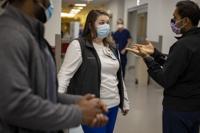
Clinical pharmacy specialists Jimmy Pruitt III, nurse Brittany Arrington and Dr. Tejas Nadig discuss the care for a patient in the Medical University Hospital’s emergency room at the Ashley River Tower on Friday, Dec. 18, 2020, in Charleston. Grace Beahm Alford/Staff
On a Friday in early August, Arrington felt chills. She ran a fever.
On Saturday, she tested positive. Given the pregnancy left her too tired to leave the house much beyond work, she figured she got it at the hospital. She had worked up to the day before.
On Sunday, mild contractions tightened across her midsection. Arrington was 33 weeks pregnant, still a good month away from being full term for twins.
I must be dehydrated, she figured, and headed to the hospital.
At first, her twins looked fine. Then, one of the girls’ heart rate dropped with each contraction. It became worse and worse, then downright alarming.
Arrington would need to deliver them in an emergency C-section.

Four-month-old twins Emory, held by father Colt Arrington, and Emerson, held by mother Brittany Arrington, at home with their sister Addison, 3, on Sunday, Dec. 20, 2020, in Charleston. Grace Beahm Alford/Staff
She was terrified. COVID can cause patients’ blood to clot too much — or barely at all. A blood test showed a steep drop in Arrington’s platelets, which help plug injured blood vessels.
Nonetheless, a crew whisked her to a C-section room.
After the twins were born, still so little, an anesthesiologist peered around the drape between Arrington’s head and midsection.
“We’re having a really hard time getting your bleeding to stop. Are you feeling OK?”
Arrington glanced at the monitor and tried not to panic.
It became clear she also needed an emergency hysterectomy in an attempt to stop the bleeding. As the team hurried her to an operating room, Arrington clung to thoughts of her twins: Were they OK?
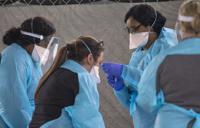
It was the last time she was alert for two days. Because she bled so much, her condition so critical, a doctor intubated her. She received enough units of blood products to fill her body three times. For 48 hours, she remained on a ventilator in an ICU at her own hospital.
Ebbing and flowing from consciousness, Arrington noted a nurse in full PPE comforting her. “You’re in the intensive care unit. Everything is OK.”
On Wednesday, four days after she’d noticed her first symptoms, the medical team removed her from the ventilator.
“Do you know what happened?” a nurse asked. She explained the bleeding, the hysterectomy, intubation, a CT scan, back and forth to the operating room for two more procedures.
Arrington only wanted to hear about her babies. Her husband, sheriff’s Deputy Colt Arrington, was sitting outside her ICU room, given he’d tested negative. He explained over speaker phone that the twins had contracted coronavirus, too, making them the first born at the hospital with it. Both girls, Emerson and Emory, were doing well and showed no symptoms.
Arrington was hospitalized for two weeks. The newborns stayed just over a month, due to the virus and their premature birth.

Clinical pharmacy specialists Jimmy Pruitt III and Kelsey Billups discuss a patient with nurse Brittany Arrington while working in the Medical University Hospital’s emergency room at the Ashley River Tower on Friday, Dec. 18, 2020, in Charleston. Grace Beahm Alford/Staff
Three months later, then COVID free, Arrington returned to work as infection numbers crept upward again. She remembered when people hailed nurses like her as heroes. Now, she heard arguments about masks from people who didn’t think COVID was all that bad.
“It’s not just the 90-year-old lady,” she said. “It’s young people who are having bad outcomes. Yes, the masks are annoying, but if you had to stand for an hour in full PPE, sweating profusely, you’d have a different outlook about wearing one in a grocery store.”
Fighting a war
To help the public understand COVID-19, Dr. Kent Stock leans on World War II analogies. A point man in infectious disease at Roper St. Francis Healthcare, he’s among the area’s lead physicians toiling in these strange and frightening new trenches.
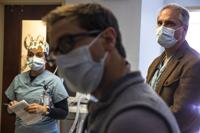
Dr. Kent Stock, an infectious-disease doctor (right), hears how patients are doing during morning rounds with doctors and nurses from various specialties on Friday, Dec. 18, 2020, at Roper Hospital in downtown Charleston. Andrew J. Whitaker/Staff
America lost 291,557 combat soldiers over four years in WWII.
It lost 330,000 people to COVID-19 over 11 months.
Stock thought he knew, on some level, what he was getting into as a younger man. He pursued his specialty in the 1990s during the AIDS epidemic, when studying emerging pathogens felt exciting.
Now, almost a year into the coronavirus pandemic, he has been involved, in some way, with all 1,600 people who have arrived at Roper St. Francis hospitals sick with COVID.
“My life has completely changed,” he said.
For him, it started early.
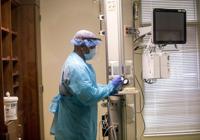
Back in mid-March, on the Monday when South Carolina schools closed, staff at a West Ashley assisted living center brought an 87-year-old resident to Roper St. Francis Hospital’s emergency room. JoAnn Stokes-Smith, a retired nurse practitioner, needed care for a urinary tract infection.
Stock also wanted to test her for the novel coronavirus.
Not everyone thought it made sense. Cases were few, symptoms unclear and tests scarce. He did it anyway.
When he got the results, he thought: I just saved 300 lives. Including, perhaps, those of his own 86-year-old parents. They lived at the same facility, in the same area, as Stokes-Smith.
What if the hospital had sent her back with COVID?
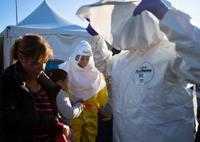
Stock was there when the elderly woman died on March 20, becoming the first person in Charleston killed by the virus. In those moments, he realized his new and dreadful mission.
In many since then, he has felt the enormity of loss.
His infectious disease practice checks on patients at several hospitals, including Beaufort Memorial. When he arrived there in July, one of its own nurses was in the ICU, languishing on a ventilator, her coworkers desperate to save her.
She’d worked there for well over a decade; her daughter also was a nurse at the hospital. The Beaufort staff pleaded with Stock to get her to Roper, which had become a hub for the system’s COVID patients.
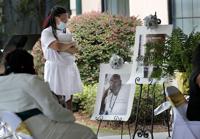
At the time, hospitals across the state were overwhelmed. Crews were creating space to treat incoming COVID patients wherever they could, stretching critical care and emergency staff to exhaustion.
Stock managed to find a bed for the nurse at Roper. For 10 days, he cared for her, watching her make incremental progress.
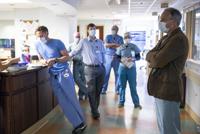
Dr. Kent Stock (far right) kicks off the morning-rounds meeting with a team of doctors and nurses on Friday, Dec. 18, 2020, at Roper Hospital in downtown Charleston. Andrew J. Whitaker/Staff
Finally, a team of doctors from multiple disciplines agreed: She was doing well enough that they would try removing her from the ventilator. Everyone was excited, none more so than the woman’s husband and daughter.
Later, Stock would tear up before finishing the story.
He was on another floor at Roper when he heard the call: Code Blue in the COVID intensive care unit. Sprinting there, he rushed to her room, already crowded. For almost an hour, the team tried to save her.
After she was pronounced dead, Stock stepped away. He breathed.
Then, he dialed her husband. Later, he would struggle to think of a more difficult moment in his life. He’d known the nurse for years.
After he hung up, he walked to a corner and sobbed. He hadn’t cried like that in three decades.
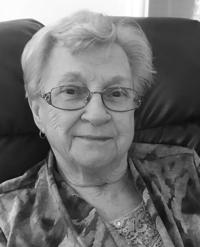
“You can do everything right and still lose a patient,” he said. “And when you know her, and a body of people plead with you to care for her. And when you disappoint them …”
The tears came again, still so fresh.
“It’s something you cannot describe for people. I have left a portion of myself in that unit.”
He rattles off the battalion of coworkers who know this unique pain: nurses, doctors, respiratory therapists, technicians, chaplains, housekeepers, discharge planners, on and on.
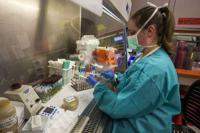
Stock was at the front of the line Dec. 16 to get a COVID vaccine, the arrival of which he sees as a critical early win in the campaign.
“We are doing this for the human race,” he said, “as did those boys who stormed Normandy.”
Yet, like that campaign in 1944, these first vaccines won’t end the pandemic. After Allied troops conquered the beaches of France, they still had to reach Germany.
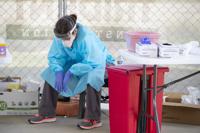
Loree Parker, a nurse practitioner with Roper St. Francis, takes a break between testing patients at a coronavirus drive-thru testing site on Rivers Avenue in North Charleston on Monday, March 30, 2020. File/Lauren Petracca/Staff
